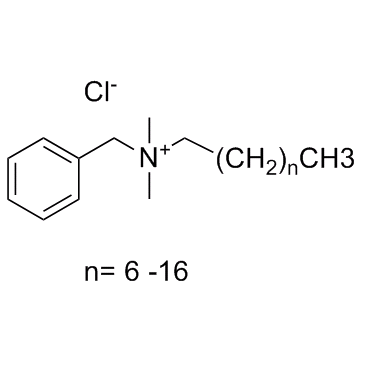苯扎氯铵,分析标准品,HPLC≥99.3%
产品编号:西域质检-TM61052| CAS NO:8001-54-5| 分子式:C6H5CH2N(CH3)2RCl (R=C8H17 to C18H37)| 分子量:354.013
Benzalkonium chloride 是一种有效的抗菌剂,在滴眼液中用作防腐剂。
本网站销售的所有产品仅用于工业应用或者科学研究等非医疗目的,不可用于人类或动物的临床诊断或者治疗,非药用,非食用,
苯扎氯铵
This certificate is designed in accordance with ISO 17034 and ISO Guide 31. This reference material (RM) was designed,produced and verified in accordance with ISO/IEC 17025, ISO 17034 and a registered quality management system ISO 9001.
(白色固体)____
常温(20±5)℃,置于阴凉处

The certified value(s) and uncertainty(ies) are determined in accordance with ISO 17034 with an 95% confidence level(k=2). Uncertainty is based on the Total Combined Uncertainty, including uncertainties of characterisation, homogeneity and stability testing. Stability values are based on real evidence opposed to simulation.
The balances used for gravimetric measurements are calibrated with weights traceable to the national standards. The calibration of the balances is verified annually by an external accredited calibration service. This analysis method has been verified using an approach consistent with ISO 17034:2016 & ISO 17025:2017.
| CERTIFICATE ON | QC SIGNATURE | |
| 2022-Oct-19 |

|
RM Release |
Water Content by Karl-Fischer Titration: 2.95%
Water Content by Karl-Fischer Titration: 2.95%
This RM is intended for use in a laboratory as a calibration and quality control standard or in method development for analytical techniques.
This reference material meets the specification stated in this certificate until the expiry date, provided it is stored unopened at the recommended temperature here in. If storage after opening is necessary, the RM should be tightly closed and kept from light and moisture.
Read Material Safety Data Sheet (MSDS) and understand any potential hazard(s) prior to the use of this product. All chemicals should be considered potentially hazardous in nature and should only be handled by qualified personnel using established good laboratory practices.
Random replicate samples of the final packaged RM have been analysed to prove homogeneity compliant with ISO 17034.
It is recommended to use 1 mg as the minimum sample size and if less material is used, to increase the certified uncertainty by a factor of two for half sample and four for a quarter of sample.Visit the support section of our website technology videos and frequently asked questions.
相关文档
化学品安全说明书(MSDS)
下载MSDS质检证书(COA)
相关产品
| 危害码 (欧洲) | C;N |
|---|---|
| 风险声明 (欧洲) | R34;R50;R21/22 |
| 安全声明 (欧洲) | S45;S61;S36/S37/S39 |
| 危险品运输编码 | UN 3261 8/PG 3 |
| WGK德国 | 3 |
| RTECS号 | BO3151000 |
|
Section 1. Chemical Product and Company Identification Benzalkonium chloride Common Name/ Trade Name Benzalkonium chloride CARCINOGENIC EFFECTS: Not available. Potential Chronic Health
MUTAGENIC EFFECTS: Not available. Effects TERATOGENIC EFFECTS: Not available. DEVELOPMENTAL TOXICITY: Not available. The substance may be toxic to kidneys, liver, heart, gastrointestinal tract, cardiovascular system, central nervous system (CNS). Repeated or prolonged exposure to the substance can produce target organs damage. Repeated exposure of the eyes to a low level of dust can produce eye irritation. Repeated skin exposure can produce local skin destruction, or dermatitis. Repeated inhalation of dust can produce varying degree of respiratory irritation or lung damage. Section 4. First Aid Measures Eye ContactCheck for and remove any contact lenses. In case of contact, immediately flush eyes with plenty of water for at least 15 minutes. Cold water may be used. Get medical attention immediately. Skin ContactIn case of contact, immediately flush skin with plenty of water for at least 15 minutes while removing contaminated clothing and shoes. Cover the irritated skin with an emollient. Cold water may be used.Wash clothing before reuse. Thoroughly clean shoes before reuse. Get medical attention immediately. Serious Skin ContactWash with a disinfectant soap and cover the contaminated skin with an anti-bacterial cream. Seek immediate medical attention. InhalationIf inhaled, remove to fresh air. If not breathing, give artificial respiration. If breathing is difficult, give oxygen. Get medical attention immediately. Evacuate the victim to a safe area as soon as possible. Loosen tight clothing such as a collar, tie, belt or Serious Inhalation waistband. If breathing is difficult, administer oxygen. If the victim is not breathing, perform mouth-to-mouth resuscitation. WARNING: It may be hazardous to the person providing aid to give mouth-to-mouth resuscitation when the inhaled material is toxic, infectious or corrosive. Seek immediate medical attention. IngestionDo NOT induce vomiting unless directed to do so by medical personnel. Never give anything by mouth to an unconscious person. If large quantities of this material are swallowed, call a physician immediately. Loosen tight clothing such as a collar, tie, belt or waistband. Serious IngestionNot available. Section 5. Fire and Explosion Data Flammability of the Product May be combustible at high temperature. Auto-Ignition Temperature Not available. Flash PointsOPEN CUP: 250°C (482°F). Flammable LimitsNot available. Products of CombustionNot available. Fire Hazards in Presence of Slightly flammable to flammable in presence of heat. Various Substances Explosion Hazards inRisks of explosion of the product in presence of mechanical impact: Not available. Presence of VariousRisks of explosion of the product in presence of static discharge: Not available. Substances Fire Fighting MediaSMALL FIRE: Use DRY chemical powder. and InstructionsLARGE FIRE: Use water spray, fog or foam. Do not use water jet. As with most organic solids, fire is possible at elevated temperatures Special Remarks on Fire Hazards Special Remarks on Explosion Fine dust dispersed in air in sufficient concentrations, and in the presences of an ignition source is a Hazardspotential dust explosion hazard. Benzalkonium chloride Section 6. Accidental Release Measures Small SpillUse appropriate tools to put the spilled solid in a convenient waste disposal container. Large SpillCorrosive solid. Stop leak if without risk. Do not get water inside container. Do not touch spilled material. Use water spray to reduce vapors. Prevent entry into sewers, basements or confined areas; dike if needed. Eliminate all Section 7. Handling and Storage Keep container dry. Keep away from heat. Keep away from sources of ignition. Do not ingest. Do not Precautions breathe dust. In case of insufficient ventilation, wear suitable respiratory equipment. If ingested, seek medical advice immediately and show the container or the label. Avoid contact with skin and eyes. Keep away from incompatibles such as oxidizing agents, moisture. StorageKeep container tightly closed. Keep container in a cool, well-ventilated area. Section 8. Exposure Controls/Personal Protection Engineering ControlsUse process enclosures, local exhaust ventilation, or other engineering controls to keep airborne levels below recommended exposure limits. If user operations generate dust, fume or mist, use ventilation to keep exposure to airborne contaminants below the exposure limit. Personal ProtectionSplash goggles. Synthetic apron. Vapor and dust respirator. Be sure to use an approved/certified respirator or equivalent. Gloves. Personal Protection in Case of Splash goggles. Full suit. Vapor and dust respirator. Boots. Gloves. A self contained breathing apparatus a Large Spillshould be used to avoid inhalation of the product. Suggested protective clothing might not be sufficient; consult a specialist BEFORE handling this product. Exposure LimitsNot available. Section 9. Physical and Chemical Properties Physical state and appearance Solid. (Amorphous solid powder or lumps. OdorAromatic. Gelatinous pieces or thick gel.) TasteBitter. (Strong.) Molecular WeightNot available. White to yellowish. Color pH (1% soln/water)Not available. Boiling PointNot available. Decomposition temperature: >140°C (284°F) Melting Point Critical TemperatureNot available. 0.98 (Water = 1) Specific Gravity Vapor PressureNot applicable. Vapor DensityNot available. VolatilityNot available. Odor ThresholdNot available. Not available. Water/Oil Dist. Coeff. Ionicity (in Water)Not available. See solubility in water, acetone. Dispersion Properties SolubilityEasily soluble in cold water, hot water. Soluble in acetone. Very slightly soluble in diethyl ether. Very soluble in alcohol. Soluble in benzene. Solubility in Benzene: 1 g dissolves in 6 ml of benzene. Solubility in Ether: 1 g dissolves in 100 ml of Ether Benzalkonium chloride Section 10. Stability and Reactivity Data The product is stable. Stability Instability TemperatureNot available. Excess heat, dust generation, moisture, incompatible materials. Conditions of Instability Incompatibility with various Reactive with oxidizing agents. substances Non-corrosive in presence of glass. Corrosivity Special Remarks onHygroscopic. Also incompatible with nitrates, anion detergents Reactivity Special Remarks onNot available. Corrosivity Will not occur. Polymerization Section 11. Toxicological Information Routes of EntryInhalation. Ingestion. Toxicity to AnimalsAcute oral toxicity (LD50): 240 mg/kg [Rat]. Chronic Effects on HumansMay cause damage to the following organs: kidneys, liver, heart, gastrointestinal tract, cardiovascular system, central nervous system (CNS). Other Toxic Effects onVery hazardous in case of skin contact (irritant), of ingestion, . HumansHazardous in case of skin contact (corrosive), of eye contact (corrosive), of inhalation (lung corrosive). Special Remarks onNot available. Toxicity to Animals Special Remarks onMay affect genetic material (mutagenic). Chronic Effects on HumansMay cause adverse reproductive effects based on animal test data. Benzalkonium Chloride is an active ingredient in vaginal spermacides. When applied in the vagina of pregnant rats at much higher doses than those used in spermacides, it caused increased resorptions leading to fetal death, and reduced litter size and weight. No adverse reproductive effects have been reported after oral treatment of rats and guinea pigs and dermal administration to rats. Special Remarks on otherAcute Potential Health Effects: Toxic Effects on HumansSkin: Causes severe skin irritation and burns. Eyes: Causes sever eye irritation and burns. Ingestion: Harmful if swallowed. May cause severe and permanent damage to the digestive tract. Causes gastrointestinal (digestive) tract burns. May affect behavior (central nervous system depression, depression) and metabolism. May produce burning pains in the mouth, throat, and abdomen, profuse salivation, muscle weakness. May also affect the respiratory system and cardiovascular system, liver and kidneys. Inhalation: May cause severe irritation of the respiratory tract with sore throat, coughing, shortness of breath, and delayed lung edema. Causes chemical burns to the respiratory tract. Causes irritation of the mucous membranes. Chronic Potential Health Effects: May affect material (mutagenic) and may cause adverse reproductive effects. Prolonged or repeated skin contact may cause dermatitis. Repeated or prolonged exposure may cause allergic reactions in sensitive individuals. May cause cyanosis of the skin and lips caused by lack of oxygen. Section 12. Ecological Information Not available. Ecotoxicity Not available. BOD5 and COD Products of BiodegradationPossibly hazardous short term degradation products are not likely. However, long term degradation products may arise. Toxicity of the ProductsNot available. of Biodegradation Benzalkonium chloride Special Remarks on theNot available. Products of Biodegradation Section 13. Disposal Considerations Waste DisposalWaste must be disposed of in accordance with federal, state and local environmental control regulations. Section 14. Transport Information DOT ClassificationClass 8: Corrosive material CLASS 6.1: Poisonous material. UNNA: 2923 : Corrosive solid, toxic, n.o.s. (Benzalkonium Chloride) PG: II Identification Special Provisions forNot available. Transport DOT (Pictograms) Section 15. Other Regulatory Information and Pictograms Federal and StateNo products were found. Regulations California prop. 65: This product contains the following ingredients for which the State of California has California Proposition 65found to cause cancer which would require a warning under the statute: No products were found. Warnings California prop. 65: This product contains the following ingredients for which the State of California has found to cause birth defects which would require a warning under the statute: No products were found. Other RegulationsOSHA: Hazardous by definition of Hazard Communication Standard (29 CFR 1910.1200). Canada: Listed on Canadian Domestic Substance List (DSL). China: Listed on National Inventory. Japan: Listed on National Inventory (ENCS). Korea: Listed on Natioinal Inventory (KECI). Philippines: Listed on National Inventory (PICCS). Australia: Listed on AICS. WHMIS (Canada) CLASS D-1B: Material causing immediate and serious toxic effects (TOXIC). Other Classifications CLASS E: Corrosive solid. DSCL (EEC)R21/22- Harmful in contact with skinS26- In case of contact with eyes, rinse and if swallowed.immediately with plenty of water and seek R34- Causes burns.medical advice. R50- Very toxic to aquaticS28- After contact with skin, wash organisms.immediately with plenty of water. S36/37/39- Wear suitable protective clothing, gloves and eye/face protection. S45- In case of accident or if you feel unwell, seek medical advice immediately (show the label where possible). S61- Avoid release to the environment. Refer to special instructions/Safety data sheets. Health Hazard HMIS (U.S.A.)3 National Fire Protection 1 Flammability 1 Association (U.S.A.) Fire Hazard 3 0 Reactivity Health Reactivity 0 Specific hazard Personal Protection j Benzalkonium chloride WHMIS (Canada) (Pictograms) DSCL (Europe) (Pictograms) TDG (Canada) (Pictograms) ADR (Europe) (Pictograms) Protective Equipment Gloves. Synthetic apron. Vapor and dust respirator. Be sure to use an approved/certified respirator or equivalent. Wear appropriate respirator when ventilation is inadequate. SECTION 16 - ADDITIONAL INFORMATION N/A |









 浙公网安备 33010802013016号
浙公网安备 33010802013016号